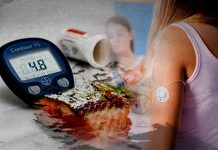
Introduction
Cells utilize glucose for producing energy. For facilitating the uptake of glucose by the cells, a hormone insulin is secreted by the pancreas. This helps in lowering the blood glucose levels in the body. In the absence of insulin, the concentration of glucose in the blood keeps on increasing, leading to a condition known as diabetes. Deficiency of insulin can occur when the pancreatic cells producing the hormone are destroyed by the immune system. This is condition is called type I diabetes. It is also known as ‘Insulin-dependent diabetes’ or ‘Juvenile diabetes‘, as it generally affects juveniles and children, though it can develop at any age. Patients require insulin injections throughout their lives for survival.
There is another type of diabetes, called Type II diabetes in which the body cells develop resistance to insulin and therefore are unable to utilize glucose from the bloodstream, causing blood glucose levels to increase.
Symptoms
The common symptoms of diabetes include the 4Ts:
1.Toilet
- Excessive urination, especially at night along with bed wetting
2.Thirsty
- Unusually high levels of thirst
3.Tired
- Difficulty carrying out normal physical activities
4.Thinner
- Body starts breaking down fat and muscle into ketones as alternate sources of energy, causing loss in body weight and muscle mass.
Other symptoms which may accompany the above mentioned symptoms are:
- Itchiness in genitals
- Blurring of vision
- Unexpected cramping
- Skin infections
Treatment
In the body, insulin is synthesized by the beta cells of the Islets of Langerhans found in pancreas. It facilitates the uptake of glucose by the cells from blood. One of the major goals of insulin is to prevent glucose level from rising too high or too low in the blood, causing hyperglycemia or hypoglycemia respectively.
Insulin given from outside acts in the similar way as the one synthesized naturally by the body. There are various types of insulin available in the market and these differ in following ways
- Source
- Onset time (time taken to start action)
- Peak (time taken to achieve maximum action)
- Duration of action (time for which insulin remains working)
- Route of administration
A. Classification according to onset time and duration of action:
1. Rapid Acting Insulin:
Rapid acting insulin starts working 15 minutes after administration, peaks in about 1 hour and is active for 2 to 4 hours. It is taken just before or with meal. Since, they act very quickly, they have an increased risk of development of hypoglycemia. This type of insulin can be injected or delivered via insulin pump.
Types:
a. Insulin lispro
Brand name: Humalog
The U.S. FDA Status: Approved, Prescription
Dosage Form: Injection
Indicated in Pregnancy: Yes, with continuous monitoring
Alcohol Content: Traces
Side Effects: Anxiety, behavior change, blurred vision, confusion, depression, dizziness, fast heartbeat, excessive hunger, headache, seizure and tingling in hands, legs and lips
b. Insulin aspart
Brand name: Fiasp
The U.S. FDA Status: Approved, Prescription
Dosage Form: i.v. Solution
Indicated in Pregnancy: Yes, with continuous monitoring
Alcohol Content: Yes
Side Effects: Hypoglycemia, anxious feeling, behavior change, blurred vision, confusion, depression, dizziness, fast heartbeat, excessive hunger, headache, seizure and tingling in hands, legs and lips
c. Insulin glulisine
Brand names: Apidra
The U.S. FDA Status: Approved, Prescription
Dosage Form: Injectable
Indicated in Pregnancy: No, unless benefits outweigh risks
Alcohol Content: Traces
Side Effects: Nightmares, anxious feeling, behavior change, blurred vision, confusion, depression, dizziness, fast heartbeat, excessive hunger, headache, seizure and tingling in hands, legs and lips
d. Prompt insulin zinc
Brand name: Humulin U
The U.S. FDA Status: Discontinued
Dosage Form: Injectable
Indicated in Pregnancy: Yes, with continuous monitoring
Alcohol Content: Traces
Side Effects: Hypoglycemia, sweating, confusion, seizures, arrhythmia, tachycardia, blurry vision, lipohypertrophy (formation of lump under the skin due to accumulation of extra fat at the site where you inject insulin), lipoatrophy (localized loss of fat tissue), hypersensitivity, formation of anti-insulin antibodies, weight gain and gastrointestinal distress
2. Short Acting Insulin:
Also known as regular or neural insulin, it is usually taken before meals. They are not as quick as rapid acting insulin. It is generally insulin from animal or human source and are injected via syringe or insulin pen. People taking short acting insulin should be aware of the risk of hypoglycemia associated with taking insulin. It takes between 30 to 60 minutes to start its action and lasts for about 8 hours.
Brand name: Humulin R
The U.S. FDA Status: Approved, OTC
Dosage Form: Injectable
Indicated in Pregnancy: Yes, with continuous monitoring
Alcohol Content: Traces
Side Effects: Hypoglycemia, weight gain, anxious feeling, behavior change, blurred vision, confusion, depression, dizziness, fast heartbeat, excessive hunger, headache and seizure
3. Intermediate Acting Insulin:
These are often taken along with short acting insulin. They start their action after 2 to 4 hours of injecting. It peaks from 4 to 12 hours and works for 12 to 18 hours. They are also known as isophane or Neutral Protamine Hagedorn (NPH). People taking NPH should be aware of the risk of hypoglycemia, particularly night time hypoglycemia.
Types:
a. Isophane insulin
Brand names: Humulin 70/30
The U.S. FDA Status: Approved, OTC
Dosage Form: Injection
Indicated in Pregnancy: Yes, with continuous monitoring
Alcohol Content: Yes
Side Effects: Allergic reaction, itching, wheezing, change in eyesight, chills, dizziness, mood changes, slurred speech, irritation at the site of injection and hypoglycemia
b. Insulin zinc
Brand names: Humulin L
The U.S. FDA Status: Discontinued
Dosage Form: Injectable
Indicated in Pregnancy: Yes, under continuous monitoring
Alcohol Content: Traces
Side Effects: Hypoglycemia, sweating, confusion, seizures, arrhythmia, tachycardia, blurry vision, lipohypertrophy, lipoatrophy, hypersensitivity, formation of anti-insulin antibodies, weight gain and gastrointestinal distress
4. Long acting insulin:
This type of insulin is often used along with rapid or short acting insulin. It is used for lowering blood glucose level when rapid acting insulin stops. It is taken once or twice a day. It is available in animal and analogue forms and can remain active up to 24 hours with the exception of bovine protamine zinc insulin (PZI), which can last up to 36 hours. It do not have any peak activity and has consistent delivery throughout the day and is injected once or twice a day.
Types:
a. Extended insulin zinc:
Brand names: Ultralente
The U.S. FDA Status: Discontinued
Dosage Form: Injectable
Indicated in Pregnancy: No
Alcohol Content: No
Side Effects: Hypoglycemia, headache, hunger, sweating, tremors, irritability, rapid breathing, fast heartbeat, fainting and seizure
b. Insulin glargine
Brand name: Lantus
The U.S. FDA Status: Approved, Prescription
Dosage Form: Injectable
Indicated in Pregnancy: No, unless benefits outweigh risks
Alcohol Content: Traces
Side Effects: Hypoglycemia, anxious feeling, behavior change, blurred vision, confusion, depression, dizziness, fast heartbeat, excessive hunger, headache, seizure and tingling in hands, legs and lips
c. Insulin determir
Brand Names: Levemir
The U.S. FDA Status: Approved, Prescription
Dosage Form: Injectable
Indicated in Pregnancy: Yes, under continuous monitoring
Alcohol Content: Traces
Side Effects: Anxiety, behavior change, blurred vision, confusion, depression, dizziness, fast heartbeat, excessive hunger, headache, seizure and troubled breathing
B. Classification According to Origin:
1. Animal Insulin:
This was the first type of insulin that was administered in humans for managing diabetes and was obtained from cows and pigs. Today, the use of animal insulin has subsided significantly and has been replaced by human insulin and human analogue insulin. However, animal insulin can still be obtained on prescription.
There are 3 different types of animal insulin available, depending on types of action and duration. These are:
a. Short Acting Insulin: It starts acting nearly 30 minutes after injection and peaks around 3 to 4 hours after injecting. Its duration of action is 8 hours.
Brand names: Not Applicable
The U.S. FDA Status: Discontinued
Dosage Form: Injectable
Indicated in Pregnancy: Yes, under continuous monitoring
Alcohol Content: Yes
Side Effects: Weakness, sweating, trembling, nervousness, excitement, irritability, hypoglycemia, swelling, redness around area of injection, wheezing, nausea, weight gain, allergic reaction and cramps
b. Intermediate Acting Insulin: It starts acting nearly4 to 6 hours after injection and peaks around 8 to 14 hours after injecting. Its duration of action is 24 hours.
Brand names: Not Applicable
The U.S. FDA Status: Discontinued
Dosage Form: Injectable
Indicated in Pregnancy: Yes, under continuous monitoring
Alcohol Content: Yes
Side Effects: Weakness, sweating, trembling, nervousness, excitement, irritability, hypoglycemia, swelling, redness around area of injection, wheezing, nausea, weight gain, allergic reaction and cramps
c. Long Acting Insulin
Brand Names: Not Applicable
The U.S. FDA Status: Discontinued
Dosage Form: Injectable
Indicated in Pregnancy: Yes, under continuous monitoring
Alcohol Content: Yes
Side Effects: Weakness, sweating, trembling, nervousness, excitement, irritability, hypoglycemia, swelling, redness around area of injection, wheezing, nausea, weight gain, allergic reaction and cramps
d. Premixed animal insulin: It is prepared by mixing short acting and intermediate acting insulin in different ratios.
Brand Names: Not Applicable
The U.S. FDA Status: Discontinued
Dosage Form: Injectable
Indicated in Pregnancy: Yes, under continuous monitoring
Alcohol Content: Yes
Side Effects: Weakness, sweating, trembling, nervousness, excitement, irritability, hypoglycemia, swelling, redness around area of injection, wheezing, nausea, weight gain, allergic reaction and cramps
2. Human Insulin:
It refers to synthetic insulin which is developed in the laboratory and mimics human insulin. It is developed by growing insulin proteins within Eschericia Coli (E.coli).
Types:
a. Regular or Short Acting Form: It starts acting nearly 30 minutes after injection and peaks around 2 to 3 hours after injecting. Its duration of action is up to 10 hours.
Brand Names: Not applicable
The U.S. FDA Status: Discontinued
Dosage Form: Injectable
Indicated in Pregnancy: No, unless benefits outweigh risks
Alcohol Content: Traces
Side Effects: Weakness, sweating, trembling, nervousness, excitement, irritability, hypoglycemia, swelling, redness around area of injection, wheezing, nausea, weight gain, allergic reaction and cramps
b. Intermediate Acting (Neutral Protamine Hagedorn): It starts acting nearly 2 to 4 hours after injection and peaks around 4 to 10 hours after injecting. Its duration of action is up to 18 hours.
Brand Names: Not applicable
The U.S. FDA Status: Discontinued
Dosage Form: Injectable
Indicated in Pregnancy: Yes, under strict supervision
Alcohol Content: Traces
Side Effects: Hypoglycemia, anxious feeling, behavior change, blurred vision, confusion, depression, dizziness, fast heartbeat, excessive hunger, headache, seizure and tingling in hands, legs and lips
c. Premixed Human Insulin: It is prepared by mixing regular and NPH insulin in different ratios.
Brand Names: Not applicable
The U.S. FDA Status: Discontinued
Dosage Form: Injectable
Indicated in Pregnancy: Yes, under strict supervision
Alcohol Content: Traces
Side Effects: Hypoglycemia, anxious feeling, behavior change, blurred vision, confusion, depression, dizziness, fast heartbeat, excessive hunger, headache, seizure and tingling in hands, legs and lips
3. Genetically Engineered Insulin:
It is the insulin produced by using recombinant genetic engineering, which has the biggest advantage of having less immunogenicity. It is more acceptable to the body and causes less reactions with the immune system. This type of insulin is genetically altered to create a more rapid acting or more uniformly acting form of the insulin. It is produced by growing insulin proteins inside E.coli and then changing the sequence of amino acid to increase the speed of action or to make the insulin act more uniformly.
Types:
a. Rapid Acting Insulin: It starts acting immediately after injecting and peaks around 1 hour after injecting. Its duration of action is 4 hours.
Brand Names: Humalog
The U.S. FDA Status: Approved, Prescription
Dosage Form: Injectable
Indicated in Pregnancy: Yes, under continuous supervision
Alcohol Content: Traces
Side Effects: Anxious feeling, behavior change, blurred vision, confusion, depression, dizziness, fast heartbeat, excessive hunger, headache, seizure and tingling in hands, legs and lips
b. Long Acting Insulin: It starts acting nearly 2 hours after injection and it is expected to work uniformly and hence, has no peak time. Its duration of action is 24 hours.
Brand name: Lantus
The U.S. FDA Status: Approved, Prescription
Dosage Form: Injectable
Indicated in Pregnancy: No, unless benefits outweigh risks
Alcohol Content: Traces
Side Effects: Hypoglycemia, anxious feeling, behavior change, blurred vision, confusion, depression, dizziness, fast heartbeat, excessive hunger, headache, seizure and tingling in hands, legs and lips
c. Premixed: It is prepared by mixing short acting and intermediate acting insulin in different ratios.
Brand Names: Humalog Mix 50
The U.S. FDA Status: Approved, Prescription
Dosage Form: Injectable
Indicated in Pregnancy: Yes, under continuous supervision
Alcohol Content: Traces
Side Effects: Anxious feeling, behavior change, blurred vision, confusion, depression, dizziness, fast heartbeat, excessive hunger, headache, seizure and tingling in hands, legs and lips
OTC Drugs Available
Insulin is available over the counter only in the U.S.A. In other countries, you are required to produce a prescription for getting insulin.










